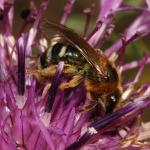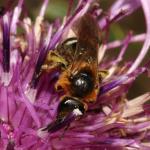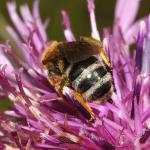Lasioglossum tricingulum CURTIS, 1833
Known as L. xanthopum in some publications.
Very local but widely distributed in southern Britain, the range extending northwards to Nottinghamshire (Carr, 1935) and South Lincolnshire. In Wales, known only from Glamorgan. Also reported from Guernsey and the Channel Islands. There are no records from Ireland. Widespread in the Palaearctic, from southern Sweden south to Morocco, and eastwards to Israel, Pakistan and Mongolia (Ebmer, 1988).
Classified by Falk (1991) as a Notable B species [now known as Nationally Scarce (Nb)].
Mainly encountered on calcareous grassland, coastal landslips and cliffs.
Females are active from early April to at least August. Males emerge later than those of most other British halictines, being found from August to mid October, with a peak in late September. As a result, this sex is not represented in most collections as collectors have generally terminated their field work before the males appear. Interestingly, on April 8th, 1993, both sexes were found commonly at Tizi 'n Tichka, one of the passes (2100m.) in the Moroccan High Atlas (G R Else and S P M Roberts, pers. obs.). The ground there is often covered by snow earlier in the spring. It would seem that the males overwinter as adults in this site, a habit unknown in northern Europe.
Nest burrows are rarely found, suggesting they often occur singly and are obscured by low vegetation. However, a huge, extended aggregation of about a thousand burrows was observed recently along about a half mile of the cutting of an abandoned railway line at Reach, Devils Dyke, in Cambridgeshire (J P Field, pers. comm.). The bee is presumed, on available evidence, to be a solitary species, rather than a eusocial one.
Sea campion (Silene uniflora), bramble (Rubus fruticosus agg.), blackthorn (Prunus spinosa), clover (Trifolium sp.), ground-ivy (Glechoma hederacea), knapweed (Centaurea spp.) and dandelion (Taraxacum officinale). Males have been collected from knapweed and field scabious (Knautia arvensis).
The bee Sphecodes spinulosus has been recorded as a cleptoparasite of this bee (Perkins, 1923, 1924; Hallett, 1928). Gigantic specimens of S. monilicornis have been observed at the burrows of L. xanthopus (Hallett, 1928). Specimens are rarely stylopized, the parasite being Halictoxenus arnoldi (Perkins, 1891, 1918, 1923).
2001




